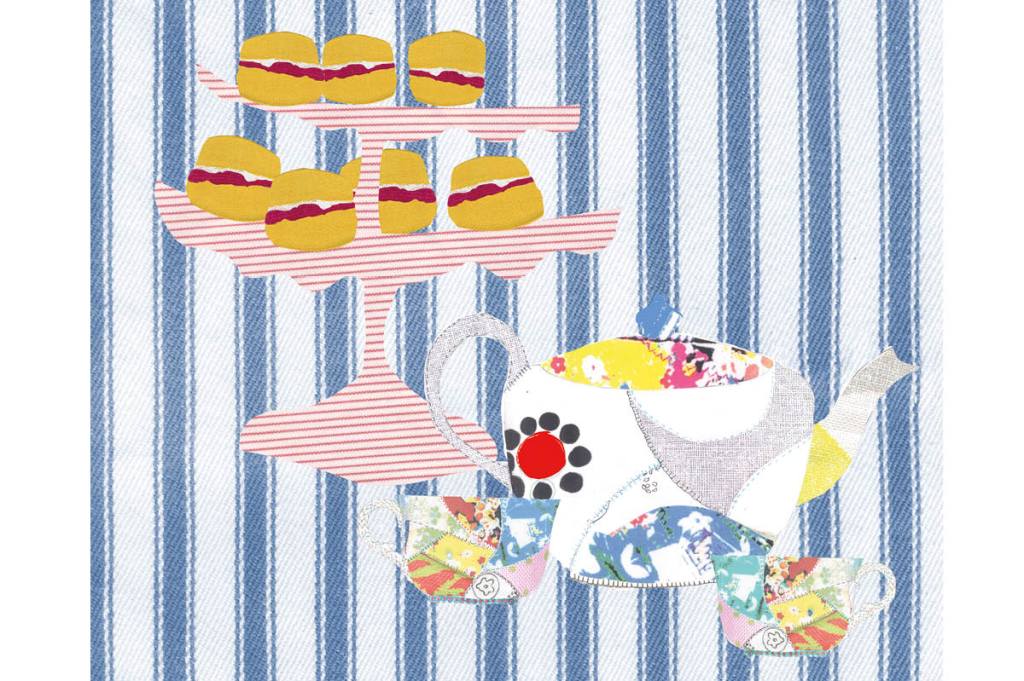It is a strange coincidence that both my sister and I, born and raised in Scotland, have married Americans. I live in New York. Lily lives in Nebraska. But we were both in our mother country over the summer visiting family and keen to make the most of our British culinary tradition.
There is more to miss than you’d think. Diluting juice, which the English call “squash,” fruit flavoring added to water. A Sunday carvery, roasted meat and potatoes, with gravy and vegetables, complete with Yorkshire pudding. Fish and chips. Real chocolate. Decent Indian food. Breakfast cereal not coated in fructose. Tea worthy of the name. And above all, freshly baked scones.
Americans may think they have scones rhyming with “stones.” But their brittle, pale, triangular carbohydrates are incomparable with the rounded, golden-topped, crumbly lightness that is a scone rhyming with “on.”
Picture them in their proper context: At afternoon tea, in the middle of a three-tiered plate with sandwiches below and cakes above, baked to perfection, served with thick clotted cream and homemade — ideally raspberry — jam. And with a teapot at the ready, of course.
You could search all fifty states, from sea to shining sea, and never come close to finding a proper scone. Much has already been written on the dire state of American tea. (See George Orwell and Christopher Hitchens.) Clotted cream is tragically absent in the US, thanks to the FDA which, in its wisdom, has banned it along with haggis. As for jam, good stuff can be found if you look hard enough, but the typical product you’ll run into is American “jelly,” a sticky, gelatinous substance with only traces of fruit.
American readers may huff at this description. Yet for those uninitiated to the delights of an afternoon tea they are — to borrow from C.S. Lewis’s description of mankind’s fallen nature — but ignorant children who want to go on making mudpies in slums because they cannot imagine what is meant by the offer of a holiday at the sea.
To find the perfect scone we needed to get out of Glasgow, or so we thought. Lily suggested a visit to Culross — pronounced coo-rus by the locals — a village on the east coast of Scotland in the peninsula of Fife.
It was a rare day of Scottish sunshine. White and yellow houses shone brightly under a blue sky. By the waterfront, a cheerful duo in a 1950s-style van sold homemade ice cream. A fiddler played in the town square.
We decided to make the most of the main tourist attraction, Culross Palace, featured in the TV series Outlander. There was some interesting background information about the former royal burgh’s historical importance for coalmining and as a seventeenth-century port on the River Forth, and some well-kept rooms. Best of all was the palace garden, sloped with stairs, which offered spectacular views of the village.
After that, it was time for lunch. We went to Bessie’s café, a quaint eatery on a cobbled street next to the palace. As we approached, we heard the chef singing along to The Sound of Music from the kitchen window. The menu had only a few options. Cakes, sandwiches, or soup and a scone of which there were cheese, fruit, and treacle. Underneath the chalked-up menu were brown paper bags marked “four plain yesterday’s scones, £1.50.”
Nick, my husband, went first.
“I’ll have soup, please, with a fruit scone.” The server looked askance at him. “The soup doesn’t come with a fruit scone,” she said, pointing to the menu. “It comes with a cheese scone.”
Nick looked at the menu and then behind her at the stack of fruit scones next to a stack of cheese scones, wondering what extraordinary, invisible force might be preventing her from simply taking a scone from one pile and not the other.
He acquiesced, paid and went outside to wait.
Next was Daniel, Lily’s husband. Holding a bag of yesterday’s plain scones in his hand, he approached the counter.
“I’ll have these, please,” he said, pointing to the bag, “and some clotted cream and jam.” The same expression. “You can’t eat those here,” she said. “They’re for takeaway only.” Daniel looked back at the menu to see where he’d missed these vital terms and conditions. But these rules were unwritten.
We sat at the table outside on the cobbled terrace, Daniel with the fruit scone Nick had wanted, and Nick with the cheese scone no one had wanted, and marveled at how different customer service is in the land of the free. The fiddler played on in the distance.
As it turns out, the best scone experience of the trip was in Glasgow at the Willow Tea Rooms on Buchanan Street in the city center. Lily and Daniel had returned to the United States at this point. But Nick and I, along with my parents, brother John and cousin Louise, arranged an afternoon tea.
The tea rooms were designed by the famous Scottish architect Charles Rennie Mackintosh. Their original premises on Sauchiehall Street first opened in 1903. The chairs have Mackintosh’s fashionably long backs, uncomfortable to sit in, and the table wasn’t quite big enough for a party of our size.
My dad, Nick, Louise and I ordered the traditional afternoon tea, while my mum ordered a savory version — the dreaded cheese scone instead of fruit and plain, and hors d’oeuvres instead of cakes. John arrived late and wanted lunch. We clambered over teapots, plates, and glasses of Irn-Bru, a bright orange drink peculiar to Scotland, that Nick says tastes like “cotton candy.”
It was not quite the civilized, relaxing afternoon we’d planned. Dad made sure everyone had a fair share of finger sandwiches, four per person, going round the table asking, “How many have you had?” The distribution of sandwiches was complicated in that neither Louise nor I like egg mayonnaise (egg salad, Americans). What’s supposed to be a leisurely all-afternoon affair was over in about forty-five minutes, prompting our waitress to observe (using the Scottish second-person plural): “Yous must have been hungry.”
Oh, but the scones. The scones, the scones, the scones! They were fluffy on the inside, oven-kissed and crumbly on the out- side, topped off with a dusting of icing sugar and served with the best clotted cream and raspberry jam I’ve ever tasted. Absolute perfection. Just thinking about them is almost enough to make me book the next red-eye across the Atlantic.
This article was originally published in The Spectator’s March 2024 World edition.


























Leave a Reply